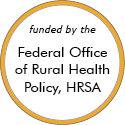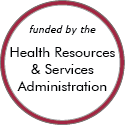Rural Project Examples: Racial and ethnic groups
Effective Examples
Care for Our Elders/Wakanki Ewastepikte
Updated/reviewed June 2024
- Need: To provide Lakota elders with tools and opportunities for advance care planning.
- Intervention: An outreach program in South Dakota helps Lakota elders with advance care planning and wills by providing bilingual brochures and advance directive coaches.
- Results: Care for Our Elders saw an increase in the number of Lakota elders understanding the differences between a will and a living will and the need to have end-of-life discussions with family and healthcare providers.
HoMBReS
Updated/reviewed May 2024
- Need: To reduce the risk of HIV/STDs among Latino men living in rural regions of the United States.
- Intervention: Soccer team leaders are elected and trained as lay health advisors to promote sexual health education among team members.
- Results: Program participants report an increase in HIV testing, an increase in condom use, and an increase in awareness of how to prevent the transmission of HIV.
Salud es Vida Cervical Cancer Education
Updated/reviewed January 2024
- Need: To deliver information about cervical cancer to rural Hispanic women in the United States.
- Intervention: The development of a lay health worker (promotora) curriculum that provided information on cervical cancer, HPV, and the HPV vaccine to Hispanic farmworker women living in rural southern Georgia and South Carolina.
- Results: Significant increases in post-test scores relating to cervical cancer knowledge and increases in positive self-efficacy among promotoras.
The Pacific Care Model: Charting the Course for Non-communicable Disease Prevention and Management
Updated/reviewed October 2023
- Need: The U.S. Associated Pacific Islands (USAPI) needed an efficient, effective, integrated method to improve primary care services that addressed the increased rates of non-communicable disease (NCD), the regional-specific phrase designating chronic disease.
- Intervention: Through specialized training, multidisciplinary teams from five of the region's health systems implemented the Chronic Care Model (CCM), an approach that targets healthcare system improvements, uses information technology, incorporates evidence-based disease management, and includes self-management support strengthened by community resources.
- Results: Aimed at diabetes management, teams developed a regional, culturally-relevant Non-Communicable Disease Collaborative Initiative that addresses chronic disease management challenges and strengthens healthcare quality and outcomes.
Strong African American Families-Teen Program
Updated/reviewed May 2023
- Need: There is a lack of interventions that addresses teenager behavioral problems, particularly for rural African American adolescents.
- Intervention: Rural, locally trained leaders administered five 2-hour meetings for teenagers and their primary caregivers. Trainings focused on reducing risks that prevent positive development, specifically sexual risk-taking that can lead to HIV and other STIs.
- Results: Teens reported reduced conduct problems, depressive symptoms, and substance abuse. Families were strengthened, and SAAF-T reduced unprotected intercourse and increased condom efficacy.
Vivir Mejor! (Live Better!) System of Diabetes Prevention and Care

Updated/reviewed August 2022
- Need: To address high rates of diabetes in rural Hispanic/Latino populations near the U.S.-Mexico border.
- Intervention: A comprehensive, culturally competent diabetes education program was implemented in Santa Cruz County, Arizona.
- Results: Since 2012, this program has helped participants better manage their diabetes and increase healthy living behaviors.
Promising Examples
Health without Borders


Updated/reviewed January 2024
- Need: To improve the health of communities in the south central region of New Mexico.
- Intervention: A program was developed to specifically address diabetes prevention and control, behavioral healthcare, and immunization in Luna County.
- Results: During the program, 1,500 immunizations were distributed, baseline measurements of participants improved, and 935 new patients were seen for behavioral health issues.
Faith, Activity, and Nutrition
Updated/reviewed August 2023
- Need: To increase healthy eating and physical activity levels in Fairfield County, South Carolina.
- Intervention: Community health advisors trained church committees and delivered telephone-based technical assistance to improve opportunities, guidelines, messages, and pastor support for physical activity and healthy eating.
- Results: In a 2018 study, churchgoers reported seeing more opportunities for physical activity as well as more messages and pastor support for physical activity and healthy eating. Intervention churches also had fewer inactive churchgoers, compared to control churches.
School-Based Health Center Dental Outreach

Updated/reviewed July 2020
- Need: To improve the oral health status of children ages 3 to 17 living in underserved rural areas of Louisiana.
- Intervention: School-based nurse practitioners perform oral health assessments, apply fluoride varnishes when indicated, and make dental referrals, with completion rates of the latter tracked by dental case managers.
- Results: Significant numbers of school children are receiving oral health examinations, fluoride varnish applications, and receiving care coordination to improve numbers of completed dental appointments.
Other Project Examples
Wisconsin Tribal Elder Food Box Program
Updated/reviewed June 2024
- Need: To address food insecurity and limited access to healthy foods among Indigenous elders living in tribal nations in Wisconsin.
- Intervention: The Tribal Elder Food Box Program distributes biweekly boxes filled with culturally relevant, locally-sourced meat, produce, and shelf-stable foods to elders in all 11 federally recognized tribal nations in Wisconsin – 10 of which are located in rural areas.
- Results: In 2023, the program distributed 28,500 boxes and purchased a majority of food products from Indigenous producers and growers.
For examples from other sources, see:
